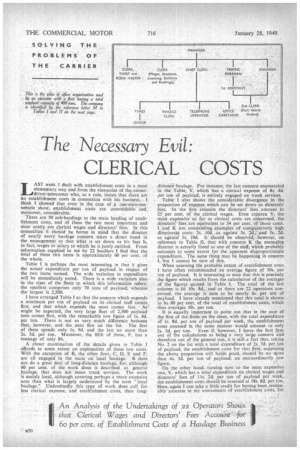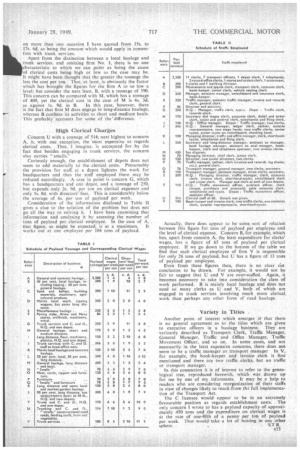The Necessary Evil:
Page 26

Page 27

If you've noticed an error in this article please click here to report it so we can fix it.
CLERICAL COSTS
I]• ST week I dealt with establishment costs in a most elementary way and from the viewpoint of the ownerriver-newcomer who, as a rule, insists that there are
• no establishment costs in connection With his business. I think I showed that even in the case of a nne-rnamonevehicle show, establishment costs are unavoidable and, moreover, considerable. .
• There are 30 sub-headings to the main heading of establishment costs, and of these the two most important and most costly. are clerical wages and directors' fees. In this connection ' it . should be borne in mind that the director of nearly every .haulage concern . takes a direct hand in the management so that What is set down as his fees Is, in fact, Wages dr salary to which he is justly entitled. From information. supplied to me by 22 hauliersI find that the total Of these two items is approximately 60 per cent. of
' the whole. .
Table I is perhaps the most interesting in that it gives the actual expenditure per ton of payload in respect of the two items named. The wide variation in expenditure will be immediately noted.. There is a wide variation also in the sizes of the fleets to which this information refers: the smallest comprises only 70 tons of payload, whereas the largest is 2,500.
1 have arranged Table I so that the concern which expends
• a minimum per ton of payload on its clerical staff comes first, and that which expends the most comes last. As might be expected, the very large fleet of 2,500 payload • tons comes first, with the remarkably low figure of Is. 411. pet ton. There is not so very much difference between that, however, and the next five on the list. The first of these spends only is. 9d. and the last no more than 2s. 3d. per ton. Moreover, the fifth of these, F. has a tonnage of only 84.
A closer examination of the details given in Table I affords to some extent an explanation of these low costs. With the exception of B, the other four, C. D, E and F, are all engaged in the main on local haulage. B does not do a great deal of tong-distance haulage, for. although 60 per cent, of the work done is described as general haulage, that does not mean 'trunk services. The work is mainly Ideal, although covering perhaps a more extensive area than what is largely understood by the term "local haulage." Undoubtedly this type of work does .call for less clerical expense, and establishment costs, than long , , distance haulage. For instance, the last concern enumerated in the Table, V, which has a clerical expense of 8s. 4d. per ton of payload, is entirely engaged on trunk services.
Table I also shows the considerable divergence in the proportion of expense which can be set down as directors' fees. -In the first concern the directors' fees amount to 25_ per cent, of the clerical wages. Even concern V, the most expensive sO• far. as clerical costs are concerned, the directors' fees, are equivalent to 34 per cent.. of those costs. I and K are outstanding. examples of comparatively high
directoratecosts: 2s 10d.• as against 3s. 2e1., and 3s. 2d. . as against 3s. 10d. It should be observed; however, on reference to Table II, that with concern K the managing director is actually listed as one of the staff, which probably accounts to some 'extent for the apparent disproportionate expenditure.., The same thing may be happening in concern I, but I cannot be sure of this. • When assessing the probable extent of establishment costs I have often •recommended an average figure of 10s. per ton of payload. It is interesting to note that this is precisely the figure which results from the calculation of the averages of the figures quoted in Table L. The total of the last column. is £6 10s. 8d., and as there are 22 operators concerned, the average is seen to be nearly 6s. per ton of payload. I have already mentioned that this total is shown to be 60 per cent of the total of establishment costs, which
.thus averages 10s. per ton.,
It is equally important to point out that in the case of the first of the firms, on the sheet, with the total expenditure of Is. 8d. per ton of payload per week, the establishment costs assessed in the same manner would amount to only 2s. 3d. per ton. Even if, however, I leave the first firm out of the calculations as being a very large concern and therefore out of the general run, it is still a fact that, taking No. 2 on the list with a total expenditure of 2s. 7d. per tan of payload, the establishment costs for that firm, supposing the above proportion still holds good, should be.rto more than 41. 3d. per ton of payload; an extraordinarily low figure.
On the other hand, turning now to the most expensive one, V., which has a total expenditure on clerical wages and directors' . fees of I Is. 2d. per ton of payload per week, the establishment costs should be assessed at 18i..84.•Per.ton. Here, again I can take a little credit for having been reasonably accurate in my assessments of establishment costs, for
on more than one occasion I have quoted. from 15s. to 17s. 6d. as being the Amount which would apply in connection with trunk services.
: Apart from the distinction between a local haulage and trunk services. and omitting firm No I, there is no one characteristic to which we can point as being the cause of clerical costs being high or low as the case may be. It might have been thought that the greater the tonnage the less the cost per ton. That. at least, is obviously the factor which has brought.the figures for the firm A to so Iowa level: but consider the next least, B. with a tonnage of 390. This concern can be compared with M, which has a tonnage of 400, yet the clerical cost in the case of M is 4s, 3d.
as against is. 9d. in B. In this case, however, there is the fact that firm M does engaee in long-distance haulage, whereas B confines its activities to short and medium hauls. This probably accounts for some of the ' difference. A High Clerical Charges
Concern U with a tonnage of 5l4, next highest to concern A, is, with one exception. the most expensive as regards clerical costs. That. 1 imagine, is accounted for by the fact that besides engaging in trunk services, the concern also carries ." smalls."
Curiously enough, the establishment of depots does not seem to add materially to the clerical costs: Presumably the provision for staff at a depot lightens the work for headquarters and thus the staff employed there may be reduced accordingly. case in point is concern G, which has a headquarters and one depot, and a tonnage of 250, but expends Only 2s. 9d. per ton on clerical expenses and only 3s. 8d. with directorS' fees. This is considerably below. the average of 6s. per ton of payload per week.
Consideration of the information disclosed in Table II gives a clue to the solution of the problem but does not go all the way to solving it. I have been examining that information and analysing. it by assessing the number of tons of payload per clerical .employee. In the case of A.
that figure, as might be expected; is 'at a maximum. It works out at one employee per 104 tons of payload. Actually, there does appear to be some sort of relation between this figure for.tons of payload per employee and the level of clerical expense. Concern B, for example, which has, apart from concern A, the least expenditure for clerks' wages, has a figure of 65 tons of payload per clerical employee. If we go down to the bottom of the table we find that each clerical employee of firm V is responsible for only 26 tons of payload, but U has a figure of 13 Ions of payload per employee.
Even from these figures then, there is no clear cut conclusion to be drawn. For example, it would not be fair to suggest that U and V are over-staffed. Again, it becomes necessary to take into consideration the class of work performed. B is mainly local haulage and does not need so many clerks as U and V, both of which are engaged in trunk services involving much more clerical, work, than perhaps any other form of road haulage.
Variety in Titles
Another point of interest which emerges that there
is no general agreement as to the titles which are given to executive officers in a haulage business. They are variously described as Transport Clerk, Traffic Manager, General Manager, Traffic and Office Manager, Traffic Movement Officer, and so On. in sonic cases, and not necessarily in the least expensive concerns, there does not seem to be a traffic manager or.transport manager In V. for example, the hook-keeper and invoice clerk is first mentioned and there are two traffic clerks, but no traffic
or transport manager. .
In this connection it is of interest to refer to the genealogical tree, reproduced herewith, which was drawn up for me by one of my. informants. It may be a help to readers who are considering reorganization of their staffs in view of changes likely to result from thz full implementation of the Transport Act.
The C licensee would appear to be in an extremely favourable position as regards establishment coats. The only concern I wrote to has a payload capacity of approximately 450 tons and the expenditure on clerical wages is at the rate of one-fifth of a penny per ton of payload per week. That would. take a lot of beating in any other •
sphere. S.T




























